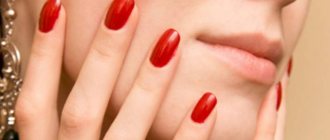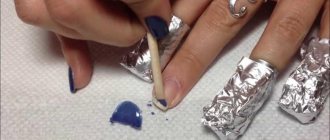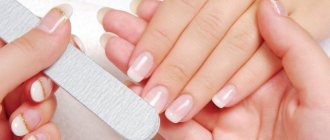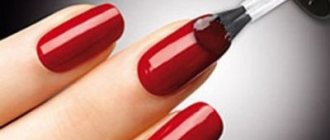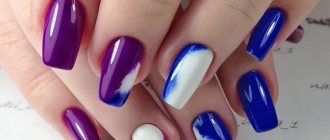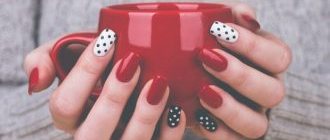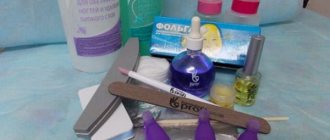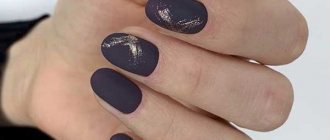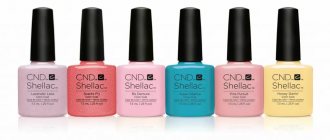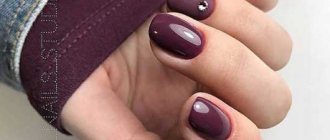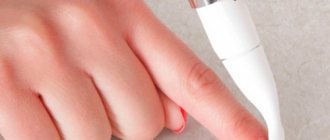You wear bright nail polish
Most often this happens when working with red, yellow, orange, black, blue and purple coatings: the pigments included in the products eat into the nail plate. The varnishes themselves, if they are made by a trusted manufacturer, are harmless, but when they are used, yellow spots may remain on the nails, which do not disappear even after treatment with nail polish remover.
What to do: New York City dermatologist Dana Stern reminds us to protect your nails with base coats when working with bright polishes. She notes that her clients often forget about this habit. In addition, soon after removing the polish, it is worth treating the plates with baking soda and hydrogen peroxide: the mixture will remove any remaining pigment and lighten the nails. After the procedure, you need to take care of nourishing your fingertips - when dehydrated, the plates can become thinner and absorb color more strongly.
What does this mean for women?
Yellowness of fingernails not only worsens their appearance, but also creates the impression of local or systemic disorders. Therefore, finding out the cause of the changed color is not just desirable, but an extremely necessary aspect for every woman. The problem can be solved only by identifying its source.
External causes of yellowness
When looking for the causes of yellowing nails, you should first think about the negative influence of external factors. This is the least dangerous and, perhaps, the most favorable situation in terms of further correction.
Can gel polish turn yellow?
When a beautiful and stylish manicure becomes a daily necessity, the nail plate may also suffer. In this case, yellowing is caused by the following reasons:
• High density of coating (impaired breathing and moisture intake). • Presence of harmful substances (acetone, formaldehyde, toluene). • Applying varnish without creating a protective layer (base). • Manicurist mistakes.
Too frequent use of gel polish or nail extensions without interruption negatively affects the condition of the nails. The plate becomes thinner, delaminates and changes its natural color. And microtraumas received when cutting down the old coating create conditions for the proliferation of fungi.
Yellowing of nails after applying gel polish is a fairly common phenomenon that many manicure lovers encounter.
What causes yellow skin on fingers?
In everyday life, a woman encounters various substances, but their influence is not always favorable. And the skin of the fingers is the first to come into contact with harmful agents, which affects its condition. Yellowing of the epithelium around the nails can be caused by:
• Cigarette smoke. • Household chemicals. • Dyes. • Certain medications.
Very often, the skin on the fingers turns yellow after processing carrots, pumpkins, potatoes, peeling nuts, or drinking coffee frequently. When smoking, tarry substances from cigarettes settle on the fingers; changes in skin color can also be caused by medicinal substances (iodine, potassium permanganate). Household chemicals, which are strong oxidizing agents, also have a similar effect.
Pathological processes
Changes in the color and structure of the nail often become a sign of a pathological process. The most common condition requiring attention is onychomycosis, a fungal infection of the plate. But yellowness of the nail can also be caused by systemic diseases:
• Psoriasis. • Hemosiderosis. • Hepatobiliary pathology. • Endocrine disorders. • Various intoxications. • Tumor processes. • Hypovitaminosis. • Atherosclerosis. • Syphilis, etc.
In this case, the yellow color usually occurs as a result of trophic changes when the nail does not receive enough nutrients, oxygen and moisture. This happens against the background of microcirculatory disorders, lymphostasis, and metabolic disorders.
When your nails turn yellow, you need to pay attention to your health status, because this phenomenon can be caused by various diseases.
Low-quality materials were used in the gel polish coating
Typically, the plates change color if the master used expired or cheap products, and also neglected degreasing and using a primer. In this case, you need to not only lighten your nails, but also strengthen them.
What to do: try to use baths with sea salt, lemon juice, apple cider vinegar or chamomile - mix a tablespoon of the active ingredient with a glass of warm water 1-2 times a week. Soak your hands in the liquid for 10–15 minutes. To consolidate the effect, it is worth doing 8–10 procedures over 2 months.
Fungal infection on nails
Most often it appears on the legs, but the fungus also attacks the arms. If you don’t take action, your nails will become thicker over time and begin to loosen and crumble.
What to do: If you've just encountered yellowing, treat your nail plates with tea tree oil. It will not only lighten your fingertips, but also destroy pathogenic particles. If the nail thickens, immediately contact a dermatologist: he will prescribe antifungal drugs for internal and external use. Read on topic:How to restore nails after summer
Yellowness of nails during pregnancy
The pregnancy period is characterized by great changes in a woman’s body. They are often caused by hormonal destabilization. This has a negative impact on the condition of the nails. They not only break, but also turn yellow. You should consult your doctor to rule out diseases that also cause changes in nail color.
Timely diagnosis will reveal the true causes of dyschromia. Due to hormone surges, the nails of pregnant women may acquire a brownish tint.
Based on the test results, the attending physician prescribes treatment. The circle of specialists who determine the essence of the problem:
- dermatologist;
- gynecologist;
- mycologist
Therapy for pregnant patients is carried out using gentle means. If the cause of yellowing of the plates is a disrupted hormonal balance, then the problem will resolve itself over time.
Do you have psoriasis?
Sometimes it can appear along with rashes on the head and torso: as a rule, in this case the nail becomes cloudy and covered with grooves.
What to do: if you encounter complications, contact a dermatologist immediately. Be mentally prepared for the fact that treatment will take a long time. During this period, it is necessary not only to follow the specialist’s instructions, but also to intensively care for your nails - cut them short, protect them from microtrauma, avoid hardware manicure, and cover the plates with clear varnish. In addition, it is worth performing mechanical work only with gloves - this will protect your fingers from damage.
Yellow nails: prevention
The main rule is hygiene, maintaining immunity and general health. Avoiding yellowing is easier than treating it. Following these recommendations will help with this:
- For manicure, use a sterile instrument. Carefully file the edge from the corners to the center to avoid delamination and the penetration of fungal infection.
- Use only high-quality cosmetics; apply a protective agent as a base before coating.
- After washing, dry your hands with a personal towel or paper napkins.
- Adjust your diet. It must be balanced in proteins, fats, and carbohydrates. If there are no contraindications, include dishes from cereals, vegetables, fresh fruits, and vegetable oils in the menu. Don't forget about foods rich in B vitamins: meat, liver, whole grain bread.
- When doing laundry, gardening, and cleaning your apartment, use rubber gloves.
- Don't get carried away with polishing or extensions. Leave your nails in their natural state often.
- Follow your doctor's recommendations during treatment, do not exceed the prescribed dosage of medications, and report any changes to your specialist.
- Remove the decorative coating periodically and walk around without it for a while. Do not use too bright shades or protect the surface with a special base coat.
Beauty requires constant care and careful attention to your health. Your hands will always be in perfect condition. To do this, it is not at all necessary to visit a nail salon, just a little free time and desire. What do you do?
It's worth getting a medical examination
Sometimes nails can turn yellow due to disorders of the body: with hypothyroidism, Itsenko-Cushing's disease, diabetes, diseases of the cardiovascular system, oncology, tuberculosis. They develop slowly and imperceptibly, however, by identifying changes in appearance in time, you can get rid of serious ailments.
What to do: make an appointment with a therapist and explain the situation. In the future, he will make an appointment with an endocrinologist, cardiovascular surgeon, or oncologist. You may also need to undergo general tests and a physical examination.
Causes of yellowed nails
Only a doctor can make an accurate diagnosis after conducting a series of studies. The yellowness of the plates indicates the presence of sand, stones in the kidneys, damage to the body by hepatitis, and other disorders of liver function. Most often, such pathologies are accompanied by yellowness of the whites of the eyes. The color of the eyeball does not change, unlike nails, in the presence of problems with the cardiovascular and endocrine systems.
If the yellowness of the plates is associated with a fungal infection, then the pathology can be identified by accompanying signs:
- spots or deformations on the nails;
- specific smell;
- plate delamination.
You cannot delay going to the doctor; the lack of adequate treatment leads to loss of the nail. Among the reasons leading to the appearance of yellowness on nails is a lack of vitamins D and E.
You can restore the natural color of your nails through cosmetic procedures. This method is suitable for solving cases not related to serious health problems. The reasons for the formation of yellowness are external factors:
- smoking;
- frequent application of nail polish and other decorative coatings;
- use of cleaning products that contain aggressive chemicals.
Yellowing of nails due to smoking is caused by exposure to harmful tars and other compounds present in tobacco.
The most harmless reasons are contact with coloring products. For example, young walnuts, raw beets, carrots, etc. To get rid of it, just wipe the surface of the nail with lemon juice.
